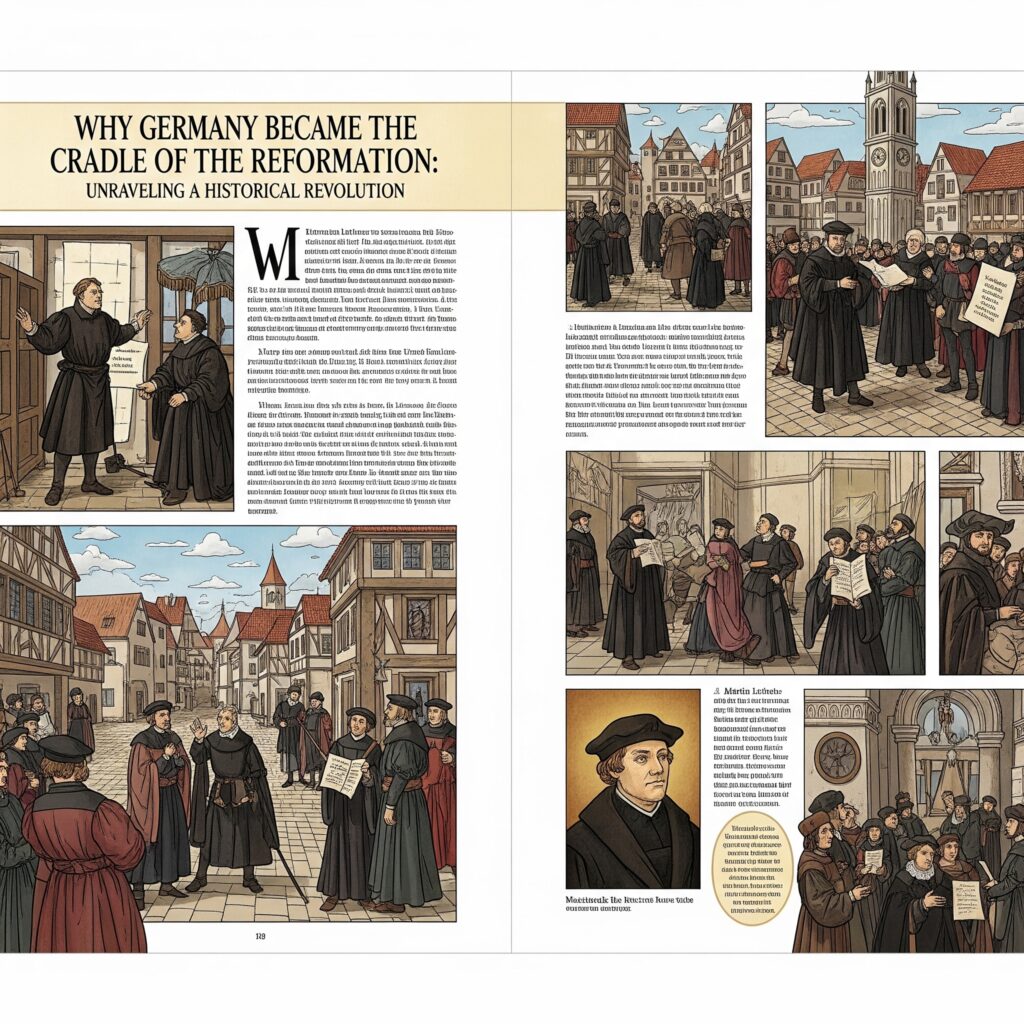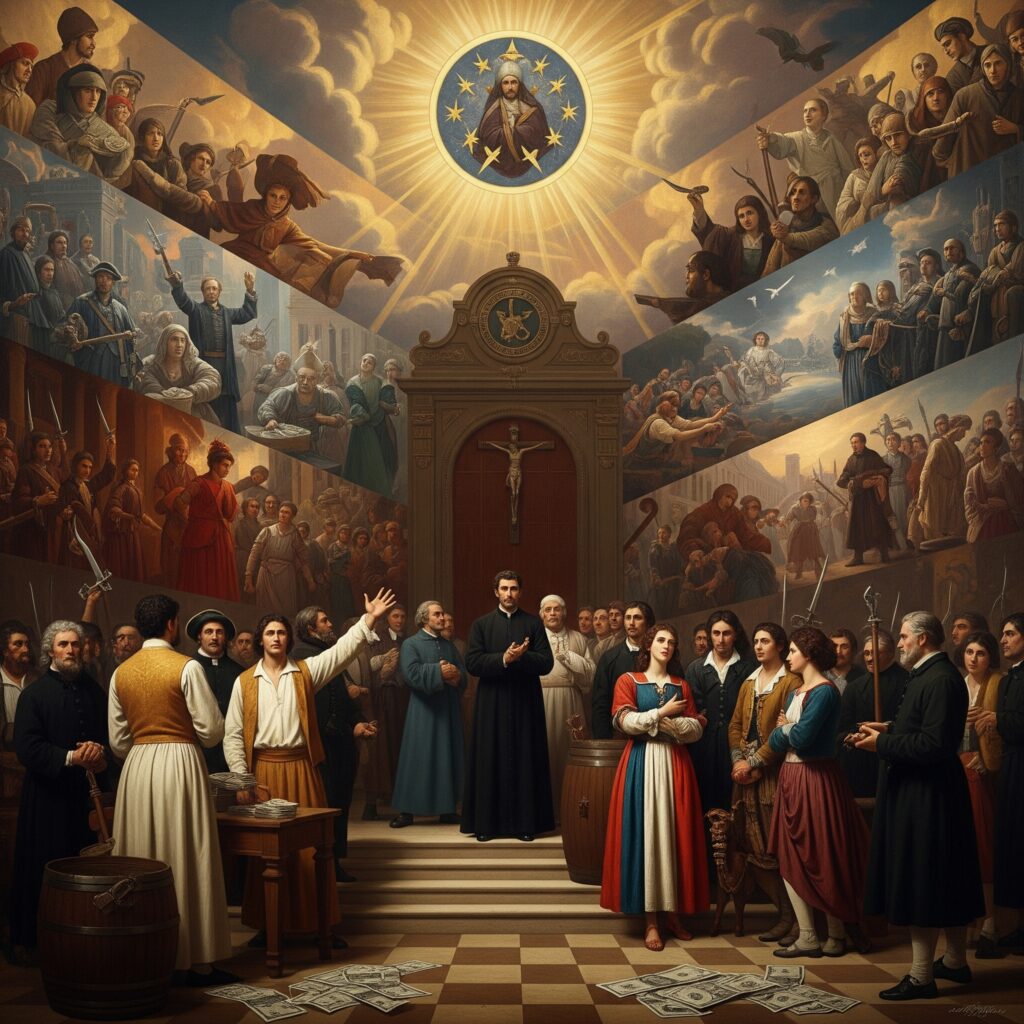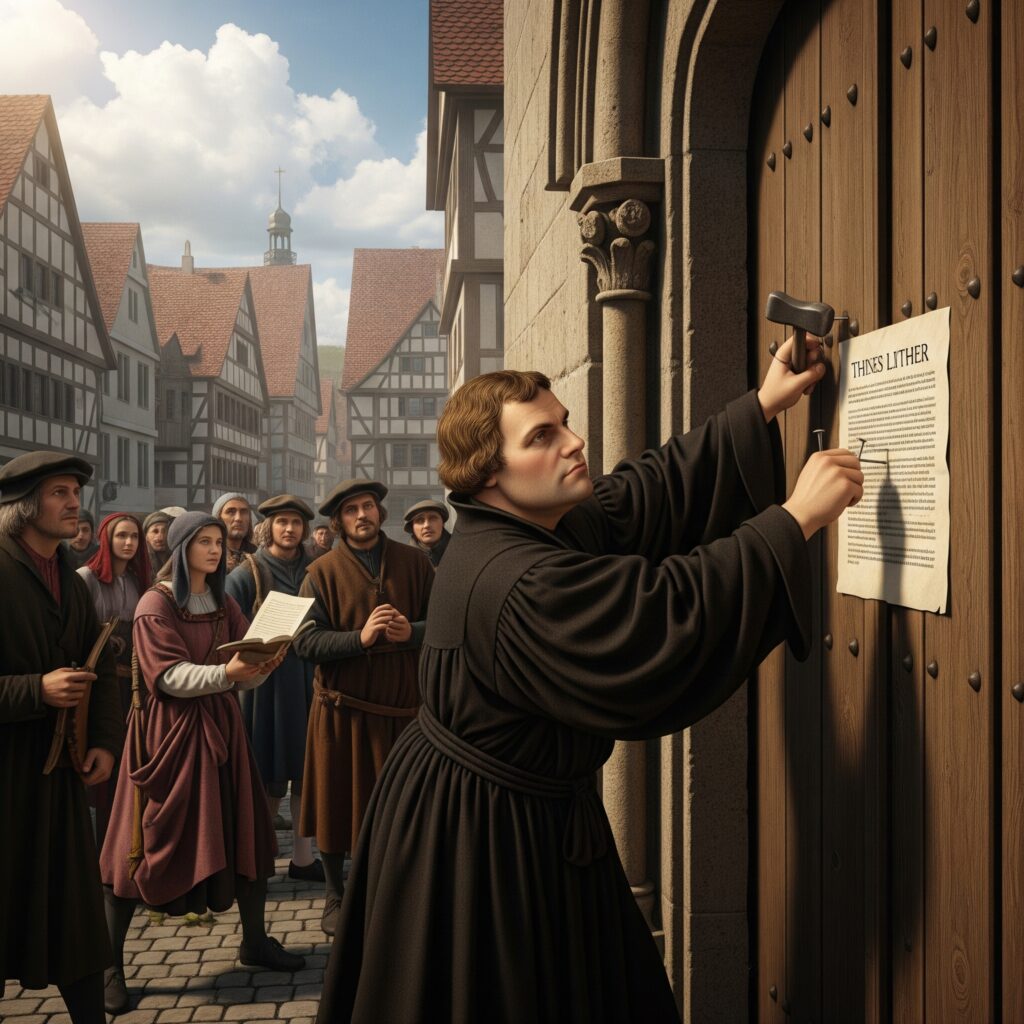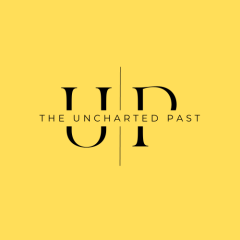What confluence of forces ignited the Protestant Reformation in Germany, rather than elsewhere in Europe? Peter Farrelly’s article, “Why Germany Became the Cradle of the Reformation: Unravelling a Historical Revolution,” confronts this fascinating question. He dissects the potent mix of societal unrest, Germany’s unique socio-political and cultural landscape, and Martin Luther’s explosive impact that together sparked this transformative upheaval. If you’ve ever wondered how a continent’s religious and political map was redrawn, this article offers a fresh and compelling perspective.

Why Germany Became the Cradle of the Reformation: Unravelling a Historical Revolution.
The Protestant Reformation, a transformative upheaval that reshaped Europe’s religious, political, and cultural landscape in the 16th century, found its genesis not in the opulent courts of Rome or the unified kingdoms of France, but in the fragmented territories of Germany. Ignited by Martin Luther’s bold act of nailing the Ninety-Five Theses to the Wittenberg church door on October 31, 1517, this movement shattered the Catholic Church’s centuries-long monopoly on Christian faith, birthing Protestantism and paving the way for modernity. Yet, the question lingers: why Germany? What confluence of historical forces, societal tensions, and individual brilliance positioned this region as the epicenter of such a radical shift? As we commemorate over 500 years since this pivotal moment, this exploration delves into three interlocking factors—deep-seated societal discontent, a uniquely prepared socio-political and cultural framework, and Luther’s unparalleled leadership—that explain why Germany became the cradle of the Reformation. Drawing on historical records and the latest scholarship, this narrative offers fresh insights for today’s readers.
The Roots of Rebellion: Anti-Clericalism, Financial Exploitation, and National Awakening

To grasp the Reformation’s origins, we must journey back to the late medieval world, where the Catholic Church reigned as the cornerstone of European society. By the 15th century, the Church extended beyond spiritual guidance, engaging in education, governance, and economic affairs, its influence woven into the daily lives of millions. Central to this authority was the medieval fixation on salvation, embodied in the “cycle of salvation”—a continuous cycle of sin, absolution, and penance. Through its seven sacraments and sacramentals, the Church held the keys to eternal life, making it indispensable to parishioners across the continent (Cameron 2012). Yet, this dominance fostered complacency, and by the early 16th century, fissures were appearing, particularly in Germany.
The first crack was a rising wave of anti-clericalism. Ordinary Germans grew increasingly disillusioned with a clergy accused of neglect and moral decay. Historical data from the period reveals a stark reality: by the late 15th century, only one in fourteen German parishes had a resident pastor, leaving many communities without spiritual leadership (McGrath 1993). Even more damning were reports of clerical misconduct. Woodcuts such as Leonhard Beck’s Monk and Maiden (1523) graphically depicted accusations of monastic exploitation, portraying monks seducing women under the pretext of spiritual authority. These images, widely circulated, inflamed public anger. High-ranking church officials took note—Cardinal Cesarini’s 1431 warning to Pope Eugenius IV that German lay people might soon turn violent against the clergy highlights the severity of this discontent (Cameron 2012).
Financial grievances deepened this unrest. The Church’s practice of simony—the buying and selling of sacred offices—drew widespread criticism, but it was the sale of indulgences that proved the tipping point. Introduced with a 1343 papal bull and legitimized under Pope Sixtus IV’s Salvator Noster in 1476, indulgences offered to reduce purgatorial time for a fee, a theological justification many viewed as a blatant money making scheme (Truman 2000). The crisis peaked in 1517 when Johann Tetzel, acting as general sub-commissary for Pope Leo X, arrived in Magdeburg to raise funds for St. Peter’s Basilica. His aggressive sales tactics, linked to a contentious deal with Albrecht of Brandenburg to accumulate multiple bishoprics, sparked outrage. Martin Luther’s Ninety-Five Theses, penned in response, condemned this exploitation, questioning why the Pope did not use his own wealth rather than burden the poor (Luther 1517). This episode galvanized support for Luther, who emerged as a voice against the “deceivers and corrupters” within the Church (Scribner 1986).
This discontent, however, was not solely religious—it carried a strong nationalistic undertone. Tensions between the Holy Roman Emperor and the Papacy had simmered since the Investiture Contests of the 11th and 12th centuries, but by the late Renaissance, these evolved into a broader anti-Roman sentiment. German princes and citizens felt exploited by Rome, which granted concessions to other European powers but withheld them from Germany. This perception fostered a belief that “Rome was the greatest thief on earth,” igniting a desire for emancipation (Varickayil 1980). Luther harnessed this sentiment, portraying the Pope as the Antichrist and promising German liberation in his 1520 appeal to the nobility. This fusion of religious reform and national identity made the Reformation a distinctly German cause, setting the stage for its explosive growth (Dickens 1974).
A Prepared Stage: Social, Political, and Cultural Dynamics
Germany’s political structure played a pivotal role in enabling this revolution, however. Unlike the centralized monarchies of Western Europe, the Holy Roman Empire was a mosaic of over 300 semi-autonomous territories, where power resided with local princes rather than a single emperor. By the 15th century, these rulers had consolidated authority, establishing chancelleries, treasuries, and judicial systems—Bavaria, for instance, boasted a fully centralized administration by 1520 (Dixon 2000). This fragmentation created a fertile ground for reform, with 65 imperial cities governed by electors determined to assert control over their domains. Among these, Frederick the Wise of Saxony stands out. Founding Wittenberg University in 1502, he provided Luther a platform as a professor of biblical studies from 1513. When Luther faced imperial wrath, Frederick’s protection—offering sanctuary at Wartburg Castle after the 1521 Diet of Worms—proved decisive (Rublack 2005). These principalities offered the “concentration of people, literary awareness, and political sophistication” needed to elevate reformist ideas to a national agenda (Cameron 2012).
Culturally, the Renaissance sparked an intellectual revolution. By 1500, Germany hosted 16 universities, where scholasticism, humanism, and spiritualism intertwined. Humanism, with its call to return to original sources (ad fontes), challenged the Church’s reliance on the Latin Vulgate. Erasmus of Rotterdam, a leading figure, published his Greek New Testament in 1516, questioning the theological basis of sacraments like matrimony by reinterpreting the Greek term musterion as “mystery” rather than a sacramental rite (McGrath 1993). His Enchiridion Militis Christiani (1503) further empowered laypeople to seek God directly, laying intellectual groundwork for later reforms (McGrath 1993). Historians describe this as a “decadence theory,” where humanists saw a return to scripture as the cure for the Church’s spiritual decline (Hamm 1999).
Significantly, the printing press, invented by Johannes Gutenberg in the 1440s, turbocharged this cultural shift. By 1500, Germany had 200 presses, producing pamphlets that transformed literary consumption. In Strasbourg, humanistic works rose from 10% of publications before 1500 to over a third by 1520, while anti-Catholic polemics dominated 42% of texts between 1519-1560 (Dickens 1974). These printed works are likened to “virtual missiles” in a “battlefield of ideas,” a phenomenon that prefigures today’s digital debates (Pettegree 2000). This technological leap, combined with a literate elite, ensured reformist ideas spread rapidly, creating a cultural foundation ripe for change.
The Spark: Martin Luther’s Visionary Leadership

Pivotally, at the heart of the Reformation stood Martin Luther, a figure whose personal resolve turned potential into action. Born in 1483, this former Augustinian monk became a theological titan through a series of defining moments. The 1518 Heidelberg Disputation, where he debated fellow reformers like Martin Bucer, and the 1521 Diet of Worms, where he stood firm with “Here I stand, I can do no other,” elevated him to national hero status. A Venetian ambassador reported in 1521 that Luther was “adored by the whole of Germany,” a reflection of his ability to harness anti-Roman sentiment (Greengrass and Dixon 1997). His strategic acumen, evident in a 1518 letter to Frederick the Wise’s secretary George Spalatin criticizing the “Italianism” of papal envoys, secured crucial support (Luther 1518).
Luther’s doctrinal contributions were equally groundbreaking. Though not a humanist, he synthesized humanistic methods with Aristotelian philosophy and nominalism to forge the evangelical movement’s core: Sola Scriptura (scripture alone) and Sola Fide (faith alone). His 1520 trilogy—To the Christian Nobility of the German Nation, On the Babylonian Captivity of the Church, and The Freedom of the Christian—called for Church reform, attacked sacramental abuses, and asserted the priesthood of all believers (Dixon 2002). These ideas provided a “center to the faith” for Germans, challenging Rome’s hierarchical control (Dixon 1999). Recent scholarship highlights how Luther’s emphasis on vernacular scripture empowered ordinary people, a legacy echoed in today’s emphasis on accessible knowledge (Heyd 2017).
Moreover, Luther’s mastery of the printing press was his strategic masterstroke. Partnering with printers like Hans Lufft in Wittenberg, he turned the city into the “New Jerusalem” of reform, producing six million pamphlets between 1518-1526. His 1523-1525 musical texts, blending evangelical messages with popular tunes, reached even the illiterate through word-of-mouth (Brown 2017). The Imperial Edict of Worms (1521) warned of his ideas “infecting” other nations, a testament to his reach (Greengrass and Dixon 1997). This media savvy “practically invented a new theological discourse,” paralleling the viral spread of ideas on modern platforms (Pettegree 2005).
A Legacy for 2025 and Beyond
The Reformation’s origins in Germany resulted from a perfect storm: societal discontent rooted in anti-clericalism and nationalism, a socio-political and cultural landscape primed for change, and Luther’s visionary leadership. Recent historiography emphasizes local agency—princes, printers, and peasants—suggesting a more collaborative effort than the traditional Luther-centric narrative (Rublack 2017). Meanwhile, online discussions in 2025 reveal a polarized legacy: some celebrate Luther as a pioneer of individual liberty, others critique his later anti-Semitic writings, reflecting a complex historical figure. In today’s world, the Reformation’s echoes are unmistakable. The power of technology to amplify ideas, the tension between institutional authority and personal belief, and the role of national identity in driving change resonate in our digital, decentralized age. As we reflect on this, what lessons can we draw? Does the Reformation’s spirit live on in movements challenging traditional power structures? Share your thoughts below, and let’s continue this historical conversation.
References:
Bainton, R.H. (1960) ‘Interpretations of the Reformation’, The American Historical Review, 66(1), pp. 74-84.
Brown, C.B. (2017) ‘Music’, in Rublack, U. (ed.) The Oxford Handbook of the Protestant Reformations. Oxford: Oxford University Press, pp. 621-642.
Cameron, E. (2012) The European Reformation. 2nd ed. Oxford: Oxford University Press.
Dickens, A.G. (1974) The German Nation and Martin Luther. London: Edward Arnold.
Dixon, C.S. (1999) ‘Introduction: Narratives of the German Reformation’, in Dixon, C.S. (ed.) The German Reformation: The Essential Readings. Oxford: Blackwell, pp. 1-32.
Dixon, C.S. (2000) ‘The Princely Reformation in Germany’, in Pettegree, A. (ed.) The Reformation World. London: Routledge, pp. 146-168.
Dixon, C.S. (2002) The Reformation in Germany. Oxford: Blackwell.
Greengrass, M. and Dixon, S. (eds.) (1997) The Protestant Reformation: Religious Change and the People of Sixteenth-Century Europe.
Hamm, B. (1999) ‘What Was the Reformation Doctrine of Justification’, in Dixon, C.S. (ed.) The German Reformation: The Essential Readings. Oxford: Blackwell, pp. 53-90.
Heyd, M. (2017) ‘University Scholars of the Reformation’, in Rublack, U. (ed.) The Oxford Handbook of the Protestant Reformations. Oxford: Oxford University Press, pp. 459-482.
Luther, M. (1517) ‘The Ninety-Five Theses, October 1517’, in Greengrass, M. and Dixon, S. (eds.) The Protestant Reformation: Religious Change and the People of Sixteenth-Century Europe.
Luther, M. (1518) ‘Luther to George Spalatin, 10 October 1518’, in Greengrass, M. and Dixon, S. (eds.) The Protestant Reformation: Religious Change and the People of Sixteenth-Century Europe.
McGrath, A.E. (1993) Reformation Thought: An Introduction. 2nd ed. Oxford: Blackwell.
Pettegree, A. (2000) ‘Books, Pamphlets and Polemic’, in Pettegree, A. (ed.) The Reformation World. London: Routledge, pp. 109-126.
Pettegree, A. (2005) Reformation and the Culture of Persuasion. Cambridge: Cambridge University Press.
Rublack, U. (2005) Reformation Europe. Cambridge: Cambridge University Press.
Rublack, U. (ed.) (2017) The Oxford Handbook of the Protestant Reformations. Oxford: Oxford University Press.
Scribner, R.W. (1986) The German Reformation. London: Macmillan.
Truman, C. (2000) ‘Luther and the Reformation in Germany’, in Pettegree, A. (ed.) The Reformation World. London: Routledge, pp. 73-96.
Varickayil, R. (1980) ‘Social Origins of Protestant Reformation’, Social Scientist, 8(11), pp. 14-31.
Author:

